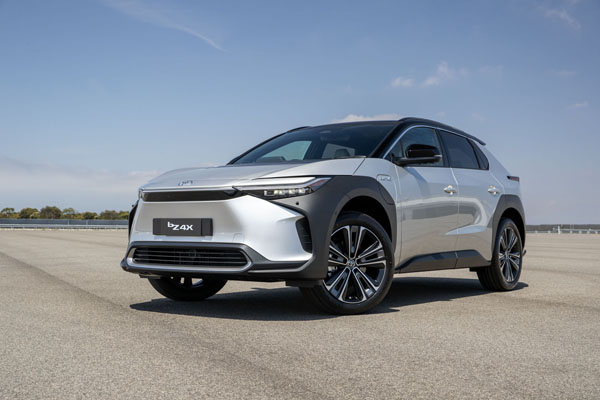
The name might sound like a robot from Star Wars, but bZ4X is actually the name Toyota
has picked for its first fully-electric vehicle, due to arrive in Australia late this year.
In fact, the ‘bZ’ stands for Beyond Zero, as in zero-emissions, while the ‘4X’ identifies that
the vehicle is a compact crossover SUV.
Under the Toyota/Subaru model sharing arrangement, which brought us the 86 and BRZ
sports cars, the bZ4X will also be sold here as the Subaru Solterra.
Available in two and all-wheel drive form, power comes from a 71.4 kWh lithium-ion battery
pack, together with a 150kW electric motor for the front wheels and 80kW unit for the rear
in all-wheel drive models.
In the all-wheel drive, total output is 160kW.
Maximum range meanwhile is understood to be 460km (WLTP) for the all-wheel drive
version.
Toyota was one of the pioneers of petrol/electric vehicles when it launched the Prius back
in 2001 and has had an on-going commitment to expanding and improving the technology.
Indeed, such has been its success that in 2022 almost one-third of Toyota’s 231,000
vehicles had hybrid-electric powertrains.
Rather than join the early rush into full and plug-in EVs, Toyota has held off in anticipation
of improvements in battery technology, vehicle range and the expansion of charging
infrastructure.
The lack of battery charging stations continues to be a significant deterrent to EV sales but
Toyota has signalled its commitment to EVs with the unveiling of a $20 million investment
by its dealers in charging facilities.
Installation of the first stage of the dealership charging network, involving 232 sites, is
underway and will be completed well ahead of the arrival of bZ4X.
Toyota’s Sean Hanley said the move by dealers to invest in charging was recognition that
facilities – and not just vehicles – had to continue to evolve to meet the changing needs of
customers.
“Our dealers will have a mix of AC and fast-charging DC outlets in prime metropolitan and
regional sites as well as smaller locations across the country, ensuring they deliver the
best possible customer experience for Toyota EV owners,” he said.
Mr Hanley said that at least two more EVs will be added within the next three years and
that, by 2030, Toyota globally plans to release 30 new EVs and lift EV sales to 3.5 million
a year.
“During the same timeframe for Australia, we are committed to offering an electrified
version of every model in our range, excluding performance cars.”
Toyota Australia has yet to provide any details of the two key factors for potential EV
buyers: price and range.
However, based on information from overseas where the bZ4X has been on sale since
mid-2022 it’s likely to cost upwards of $A70,000 with maximum range up to around 500km
– in the same ballpark as its most likely competitors, Hyundai Ioniq5 and Kia EV6.
There’s no mention in this scenario of the hydrogen-based fuel cell technology that Toyota
has also been working on over the past few years.
The company has confirmed hydrogen and fuel cell technology will play a significant role in
Toyota’s global goal of achieving carbon neutrality by 2050.
“We will continue working with Government and Industry partners to support the further
development of the hydrogen economy in order to maximise the role hydrogen can play in
a decarbonised society,” a spokesman said.
“Australians have vastly different motoring needs, and Toyota will offer a diverse portfolio
of electrified powertrains that meet the needs and circumstances of all our customers, so
that nobody is left behind.
“By 2025, we expect over half of our sales will include some form of electrification.
Whether the technology is BEV, HEV, FCEV or a yet-to-be-discovered technology, Toyota
is committed to making every effort to offer better mobility solutions for the people of
Australia and around the world.”
More specific information will be published as and when we receive it.